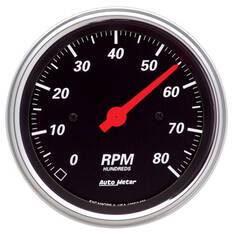Opening the Keys of Tachometers: Whatever You Need to Learn About This Important Instrument in Your Vehicle
Understanding the intricacies of tachometers can provide important insights right into your lorry's efficiency and maintenance demands. From measuring engine rate to decoding the information it provides, tachometers function as an essential device for lorry proprietors and lovers alike. By deciphering the mysteries behind this important instrument, you can open a wide range of information that can boost your driving experience and make sure the longevity of your lorry.
Value of Tachometers
The importance of tachometers depends on their ability to supply important real-time information regarding an engine's rotational speed, enabling specific surveillance and maintenance of machinery. By gauging the transformations per minute (RPM) of an engine's crankshaft, tachometers supply important insights into the engine's efficiency - tachometer. This data is crucial for making sure that the engine operates within its ideal array, preventing potential damage from over-revving or underperforming
Tachometers play an essential function in aiding operators and service technicians discover any kind of abnormalities in the engine's rate, which might show concerns such as gas inadequacy, mechanical problems, or extreme stress on the engine. By promptly determining these concerns via tachometer readings, maintenance can be done proactively, protecting against costly repair services and downtime over time.
Moreover, tachometers are especially critical in high-performance vehicles and machinery, where accurate control over engine speed is needed for ideal procedure. Competing autos, aircraft, and industrial equipment count on tachometers to deliver peak performance while maintaining security requirements. Basically, tachometers are not just instruments for determining speed but important tools for guaranteeing the smooth and reliable procedure of engines throughout different applications.
Exactly How Tachometers Procedure Engine Speed
Using sensors that identify the regularity of electrical pulses created by the engine's ignition system, tachometers accurately gauge the rotational speed of an engine. By keeping track of the price at which these pulses are gotten, tachometers provide real-time responses on exactly how quickly the engine's crankshaft is turning per min, frequently referred to as changes per minute (RPM)
The tachometer's sensing unit, frequently attached to the engine's ignition coil or ignition system cords, gets the electric signals created each time a cyndrical tube fires. These signals are then transformed into RPM analyses displayed on the gauge or tool cluster within the motorist's view. Tachometers can be analog or digital, with modern-day cars generally featuring electronic display screens for accurate and rapid RPM readings.
This details is essential for vehicle drivers to comprehend the engine's efficiency, prevent over-revving, enhance equipment shifting, and guarantee reliable fuel usage. By properly measuring engine speed, tachometers play a crucial function in assisting drivers operate their automobiles securely and efficiently.
Translating Tachometer Readings
Having a clear understanding of just how tachometers gauge engine rate sets the structure for successfully translating the RPM readings presented. Translating tachometer readings is crucial for optimum automobile performance and engine wellness. When the engine is idling, the tachometer needle normally rests around 600-1000 RPM, depending on the lorry.


Tips for Making Use Of Tachometers Efficiently
To enhance driving efficiency and maximize engine performance, what trick techniques can be carried out for successfully utilizing tachometers? Tachometers are click to read more essential tools that offer real-time comments on engine rate, making it possible for motorists to make enlightened decisions for much better efficiency - tachometer. Here are some ideas for using tachometers efficiently:
Recognizing Optimal RPM Variety: Acquaint on your own with the optimal RPM (Transformations Per Min) array for your car. This variety differs in between different cars and trucks and is usually suggested in the proprietor's guidebook. Maintaining the engine within this range can improve fuel effectiveness and lengthen the engine's life-span.
Shifting Gears at the Right Time: Use the tachometer to identify the very best time to move gears. Upshifting prematurely or as well late can lead to reduced effectiveness and efficiency. Goal to move equipments when the RPM reaches the ideal range for the next gear.
Checking Engine Stress And Anxiety: High RPMs for long term durations can stress the engine. Watch on the tachometer to avoid over-revving, especially during velocity or when bring heavy loads.
Tachometers and Lorry Maintenance
When thinking about vehicle maintenance, tachometers play an important role in keeping track of engine efficiency and discovering potential problems. Tachometers give vital information on engine speed, permitting drivers and auto mechanics to ensure that the engine is operating within the advised RPM range.
Along with detecting prospective concerns, tachometers can also help in maximizing gas efficiency. By keeping the engine rate within the optimum range, motorists can boost their gas mileage and reduce gas usage. This not only profits the chauffeur's budget however likewise adds to environmental conservation by reducing hazardous exhausts.
Final Thought
